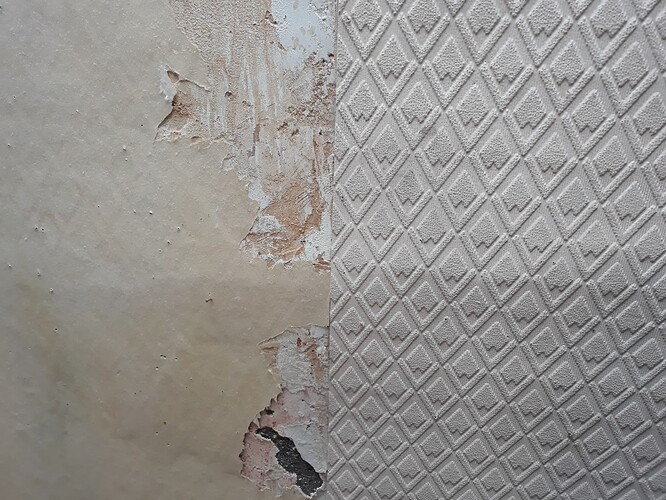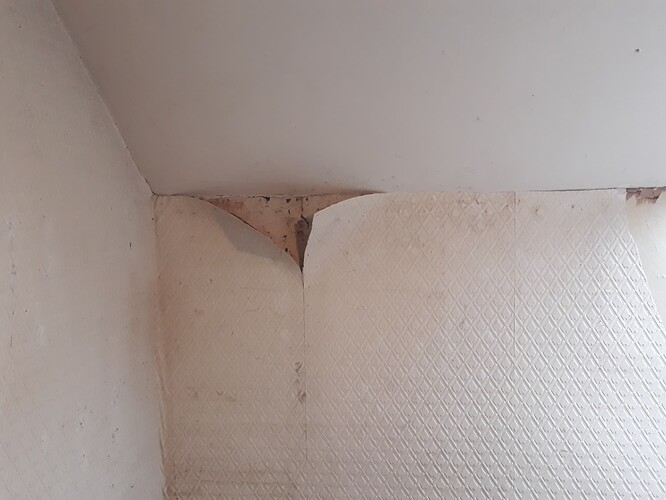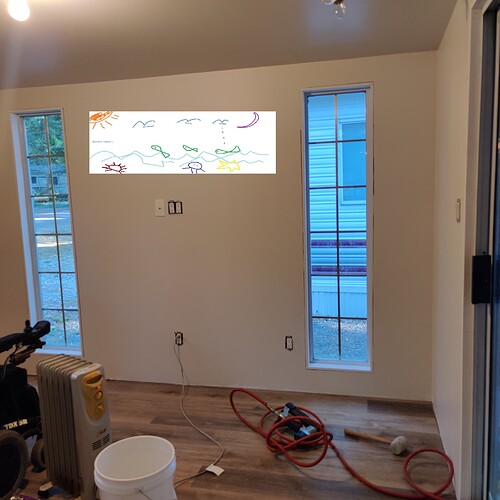This is an example
Yeegghhhh…… Looks like one of “those” jobs.
All jokes aside, have you thought of drapes / fabric covering? Looks like a full re-plaster for a proper job.
Unless you are going to do a quick fix and wallpaper again over the top (sweep it under the rug), then I can see the plaster skim is old enough that its lost its adhesion to the base wall…I can’t really see what that black is underneath. But seeing it lifting like that, I personally wouldn’t skim over the top, even if you removed all the wallpaper, as that lack of adhesion is likely to be the same across the whole wall. Any plasterers in here that would know better than me?
I’ve seen this done in the US, more care was made of the plasterboard installation than is ever done here as it’s getting plastered anyway. Construction methods on your side work very well but are utterly alien to the UK. The idea of getting a mortgage for a house that isn’t made of brick, plasterboard and plastered would have the banks running a mile.
No different once you’re inside obviously. First time (as an adult) we visited a home in the US and discovered they were wood and stucco was quite a shock. Just a literal foreign concept.
Same as done in Aus. Absolutely no-one does a full skim plaster over plasterboard like they do in UK. They always just plaster the joints
Classy, love the attention to geometry too.
yes sometimes you got to break the shape of the room abit. Interior Design 101.
Why is the sun and the moon out in the sky at the same time…? Just asking :0)
The corollary being that getting a mortgage for a house built on land you don’t really own is an order of magnitude more difficult.
I draw what I see and I see things normal beings don’t

send me the original file and I’ll make it the sleep screen on the PC I’m connecting to the TV there.
I did all of the boarding, mud/taping, and finishing in this one room and it took me two weekends. Didn’t have a choice on hiring it out, unless I hired someone in the States to do it. Turned out okay, but not looking forward to that experience again.

hold up a sec
So in the UK, they board the wall and then skim-coat it in plaster?
what? fuck nooooo, really?
before I boarded the wall, I put backing in it above the dual plugs for mounting a TV up to 55". I have a TinyPC I’ll be running it from. Lenovo M92P, about the side of a hardcover book.
I bought a house about 25 years ago from an Italian plastering family. I had never seen that done before.
I love a bit of DIY.
My wife and I bought our (first) house at auction in 2019. A 1930’s house that had been lived in since the 50s by the same person. We had to fully gut it, doing as much of the work ourselves as we could - retaining the character features where possible. New windows, front door, ceilings, re-wire, re-plumb, all new plaster etc before we moved in in 2020. I even fitted our own kitchen! We moved into our in-laws whilst doing it, but was worth it as we were able to put the money saved on rent straight into the house.
Last year we had some external works done - new roof, re-rendered, new gutters, fascia’s, soffits, asbestos garage demolished, new fencing all round etc.
Still lots of things to do to finish it but I’ve lost energy for it now (mostly decorative little jobs), plus things got so expensive. Pre-covid, we had a quote to do the external works. In the end we paid nearly double last year to what we had planned. The extension plans are well and truly on the back burner now, with construction costs and interest rates going up.
It’s only when looking back at the photo’s that you remember half of what we’ve done and makes me quite proud.
If I was tasked with that room I would decide that all old wallpaper needs taking off before assessing the wall itself. The way I normally remove old wallpaper is to fill one of those cheap hand held plant sprays with hot/warm water. Starting at the top of the wall (because excess water will run down the wall obviously)… I would spray this hot/warm water in about a 600mm square (left to right - up and down) - Enough to really soak the paper quickly.
Then with a 40mm - 50mm wide wallpaper scraper with a really flexible blade, two or three fingers of one hand at the very tip of this blade and the other hand on the handle - with very little angle from against the wall (almost parallel with it if possible)…gently run the scraper under the wet part of the old paper in strip formation - the finger tips at the edge of the blade should allow you to ‘feel’ what pressure you need to apply. Too much pressure and you will dig into the plaster skim underneath… Too much of an angle on the scraper/wall ratio and it will be akin to a chisel action… spray the wallpaper as much as you need while doing this because if it dry’s out quickly you might lift plaster skim with it.
Keep a rinseable damp cloth and small bucket handy to wipe away excess water from bare walls or light switches etc.
On exposing the walls when paper has been removed post another couple of pics - probably possible that you can get away with patching any real bad areas of plaster with a flexible type of plaster which is an easy enough job - and a Unibond sealer type coating should firm everything up until new paper is applied.
Type of new wallpaper choice will be crucial though. Thin wallpapers are a nightmare to apply and they will certainly show any flaws of the surface they are pasted to… so these I would give a miss.!
A really thick embossed wallpaper that will take plenty of paste which will also help the bonding aspect. It will help disguise and hide many of the flaws in the walls… so all things considered this wallpaper might be best choice. Run some smooth textured polyfilla down the joints with a finger before applying a Matt or vinyl silk emulsion… (This should stop the edges lifting in years to come).
Anyway that would be my plan if I was doing the works… but with any job, do it in stages and make final decision at each juncture ![]()



